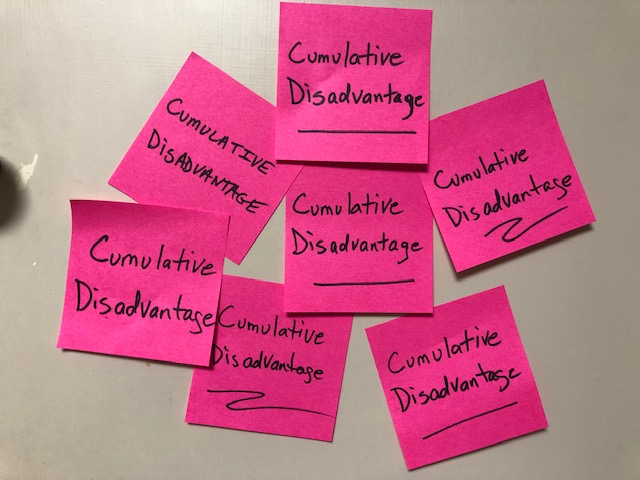Small barriers combine into huge obstacles for women in the workplace

A few years ago, I heard the term ‘cumulative disadvantage’ while listening to a podcast about gender diversity. The term caught my attention. I wrote it down on a sticky note, stuck it to the bulletin board in my office, and looked at it all the time.
Cumulative Disadvantage seemed to explain what I was often witnessing – women in the workplace face a series of small biases that add up to a serious level of discrimination.
In this article, I’ll define Cumulative Disadvantage and start a list of the small biases that accumulate to create disadvantages for women in the workplace. This list will likely grow over time.
Definition of Cumulative Disadvantage
Cumulative disadvantage apparently springs from Cumulative Inequality Theory which originally focused on scientific research and advantages to certain researchers. The theory includes two key axioms.
One axiom states that social systems generate inequality which appears over time based on demographics and processes.
The second axiom indicates that disadvantage increases exposure to risk, but advantage increases exposure to opportunity.
How does cumulative disadvantage affect women?
Cumulative disadvantage provides one explanation for why women still lag behind men. Research shows that women perform tasks as well as men and actually rate higher as leaders. Even so, organizations fail to promote as many women into senior roles and continue other disparities such as paying less.
In most cases, discrimination against women is no longer blatant. Companies showcase their diversity statements, address overt sexism, punish sexual harassment and make some attempt for gender equality.
So, why does the pattern persist?

The pattern persists because of all of the small inequities and biases that are built into education, company processes and societal expectations.
Individually, each of these issues is small. Together they create a cumulative disadvantage against all women.
Refer back to Axiom 2 of the Cumulative Inequality Theory mentioned above. The aggregate disadvantages forced on women increase their risks – such as career derailment.
The aggregate advantages given to men increases their opportunities. The differences are subtle, but significant, and add up over time.
Examples of cumulative disadvantage to women
As I write this post, I’ll include examples that are currently on my radar screen. I invite you to share additional ones and I’ll update the list.
Focus on appearance. Women are often judged first by how they look – weight, makeup, clothes – before their message is heard.

Starting salary. Women often do not negotiate salary as well when starting a job. Over time, they fall further behind.
‘Like me’. Hiring managers often feel connected to candidates who are like them. If most leaders are male, they choose more men.
Mentors. Extending the ‘like me’ phenomenon, men often choose to mentor people who remind them of their younger selves – in other words – other men.
Helpers. Women are expected to be helpers. Regardless of level and role, women are more likely to be expected to take notes in meetings, organize parties and clean up. This showcases them as helpers and not leaders.
Leader persona. The concept of ‘leader’ causes most people to think of a male leader.

Motherhood penalty. Women lose career momentum when having and raising children. They experience a much bigger hit than men who become fathers.
Unisex sizing. Team t-shirts and uniforms are often ordered in unisex sizing – which means Men’s sizing. They fit most women like tents.
Assumed constraints. When considering candidates for stretch assignments like working abroad, women sometimes get ruled out of consideration (without ever asking the women) because it is assumed they would not want to do it due to family reasons. The same thinking is not applied to men with families.
Bias of direct reports. Sometimes women are not promoted because the decision makers fear that the team would not respond well to a female leader. They permit the potential sexism of the team to derail the career of the female leader.
Personality. Women must find a perfect balance of personality and work style. Too soft and feminine is a problem and too assertive is also a problem. Men are allowed a much bigger range of personalities and excused when there is an issue.
Breadwinners. Men sometimes still receive opportunities because they are perceived as the family breadwinner and women are seen as having a support job. Some women – like me – are the primary breadwinner – but that should not be a criteria for advancement in any case.
Men in the room. When decision about promotions, talent assessments, succession planning and stretch opportunities are being made, often the only leaders in the room making the decision are men – except for the HR support person who is likely to be female.
Failure of the first – if the first female chosen to do something fails at the role, the default explanation is that women can’t be successful.
Home burden – Even in these modern days, more of the housework and childcare tends to fall to women which pulls time and attention away from work.
Generational caregiving – Women are also more likely to be the hands on caregiver for children and other family members such as grandparents or elderly parents.



